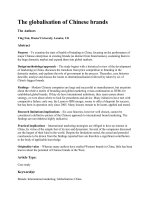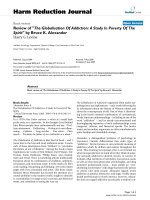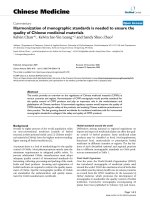The globalisation of Chinese brands.
Bạn đang xem bản rút gọn của tài liệu. Xem và tải ngay bản đầy đủ của tài liệu tại đây (340.99 KB, 16 trang )
The globalisation of Chinese brands
The Authors
Ying Fan, Brunel University, London, UK
Abstract
Purpose – To examine the state of health of branding in China, focusing on the performance of
major Chinese enterprises in creating brands (as distinct from brand names), sustaining them in the
huge domestic market and expand them into global markets.
Design/methodology/approach – The study begins with a historical review of the development of
marketing in China, discusses the transition from price competition to branding in the domestic
market, and explains the role of government in the process. Thereafter, case histories describe,
analyse and discuss the routes to internationalisation followed by taken by six of China's biggest
brands.
Findings – Modern Chinese companies are large and successful as manufacturers, but uncertain
about the relative merits of branding and global marketing versus continuation as OEMs for
established global brands. If they do have international ambitions, they seem unsure about strategy,
or even about where to look for precedents and advice. Many initiatives have met with
comparative failure; only one, the Lemovo-IBM merger, seems to offer a blueprint for success, but
has been in operation only since 2005. Many lessons remain to be learnt, applied and tested.
Research limitations/implications – Six case histories, however well chosen, cannot be
considered a definitive picture of the Chinese approach to international brand marketing. The
findings are nevertheless highly indicative.
Practical implications – International marketing strategists are obliged to have an interest in
China, by virtue of the simple fact of its size and dynamism. Several of the companies discussed
are the largest of their kind in the world. Despite the limitations noted, the actual and potential
conclusions to be drawn from the findings reported here are therefore a significant contribution to
the body of applicable knowledge.
Originality/value – Whereas many authors have studied Western brands in China, little has been
known about the potential of Chinese brands in the West.
Article Type:
Case study
Keyword(s):
Brands; International marketing; Globalization; China.
Journal:
Marketing Intelligence & Planning
Volume:
24
Number:
4
Year:
2006
pp:
365-379
Copyright ©
Emerald Group Publishing Limited
ISSN:
0263-4503
Note on currencies
The contraction “RMB” for the Chinese yuan stands for renminbi, translating as “people's
currency”. In early March 2006, the conversion rate for the yuan (RMB) was 0.12 to the US dollar
(USD), 0.07 to the pound sterling (GBP) and 0.10 to the euro.
Historical background
It is now difficult to find a shop in the West that does not sell products with a Made-in-China label.
China has overtaken Japan within the last decade to become the largest manufacturer and exporter
of consumer goods. It is believed that China is now the world's number one producer in 172
categories of different consumer and industrial products (Barboza, 2006). In the 1990s, the
country's trade growth was three times faster than the global average. Between 2000 and 2002 its
exports and imports rose by 30 per cent while world trade stagnated (WTO, 2003).
And yet, as “the world's factory” China has yet to create a single brand that is recognised
worldwide. This paper discusses the current brand revolution in China, focusing on the unique
challenge faced by major Chinese enterprises: how to sustain their brands in domestic competition
and how to expand in the global market. Key issues that affect brand transformation and
internationalisation have been identified, using case examples of manufacturers of white goods,
television sets, personal computers and microwave ovens. The main research input was a variety of
web sites, among which www.globrand.com (in Chinese) alone yielded more than 400 relevant
articles.
Despite its political history in the twentieth century, China has had a long history of commerce and
marketing. The world's first print advertisement appeared during the Northern Song Dynasty
(960-1127), for Liu's Needle Workshop in Jinan City in Shandong Province. The first European
advertisement, a poster promoting the Bible in Britain, did not appear until 300 years later
(Xinhua, 2004). “Made-in-China” was for many centuries a label for high quality and prestige
goods, imported exclusively for royals and the rich. When China's economy went into a long
decline in the nineteenth century, the reputation of Chinese-made products suffered a setback from
which it has yet to make a full recovery.
Contemporary advertising in China dates from the 1920s, since when it has experienced many ups
and downs. Examples from the 1920s to 1940s include calendar posters featuring beautiful women,
produced in Shanghai, which are now collector's items. After the first advertising boom in the
1930s, the advertising industry suffered restrictions when the People's Republic, founded in 1949,
began to implement a Russian-style centrally planned economy. During the Cultural Revolution of
1966-1976, advertising was branded evil and deceptive, and virtually disappeared. It began to
reappear in 1978, with the start of economic reform and the “open-door” policy. However, even in
the dark days of the Cultural Revolution, such brands as Panda radios and Flying Pigeon bicycles
remained sought-after products. The last decade of the twentieth century witnessed dramatic
growth in the advertising business, with average annual growth rates of jus under 40 per cent. Total
advertising revenue increased more than 28 times to 72.2 billion RMB (US$ 9 billion) between
1990 and 2000, taking China into the top ten largest markets for advertising services.
World-class brands?
Does China have any major brands, as they are understood in western terms? In a recent interview,
the chief executive of the global Ogilvy & Mather advertising agency asserted that are only brand
names that “aspire to be brands” not real brands ( Business Week , 2004 ). Chinese companies “think
branding is important, and they want to understand what a brand is. But they don't have any
experience”. The Co-Chairman of Ogilvy & Mather Asia Pacific commented in similar vein that
“brands don't exist in Korea” (Sudhaman, 2004). The majority of brands in China today are no
more than well-known names, lacking the key attribute of a real brand. There is yet a single
Chinese brand that is recognised worldwide. “Giants with feet of clay” was the pessimistic
assessment from an influential source of the ability of Chinese enterprises to compete on the world
stage ( Economist , 2004 ). Only 11 Chinese companies rank in the Fortune 500 list of top global
firms by revenue, and only two are in the FT 500, ranked by market value. Not one brand figures
in Interbrand's top hundred list.
Although Chinese brands have made evident and impressive progress in terms of
internationalisation, they still have far to go to compete with their global rivals, and the gaps are
even widening in some respects. This is demonstrated by the revenue of China's largest consumer
appliance company, Haier, which in 2002 amounted to only about ten per cent of Sony's total
electronics sales. In that same year, the combined gross electronic-systems sales of the top 30
Chinese OEMs corresponded to only 64 per cent of Hewlett Packard's sales alone ( Twice , 2003 ).
In terms of profitability the gap is even larger. China's domestic TV market has been dominated by
the so-called Big Four (Changhong, TCL, Konka and Skyworth) for some years, but the combined
profits of more than 20 domestic TV manufacturers are less than that Sony's.
However, there is also an optimistic side. The highly influential British advertising figure, Lord
Saatchi, has argued that:
China is always going to be an important element of the global ad business … but we have been
struck with the reverse potential: we don't see any reason why Chinese brands cannot have the
same impact in the US, as US brands have had in China (Xinhua, 2004).
He further points out that the laws of economics come into play in international brand
development:
There is an economic inevitability to the process. In Stage One of a nation's economic
development, a country manufactures products for others; in Stage Two, it manufactures products
to its own specifications; during Stage Three, it manufactures its own specifications for its own
brands.
In the same way that established and often complacent firms in the West were challenged by the
emergence of Japanese electronics and automotive brands in the 1960s and 1970s, and Korean
brands in the 1980s and 1990s, the world might expect the same of China. It is worth noting that
many top Chinese enterprises were barely in existence 20 years ago. They have all the potential
and opportunities to become global players in the not too far distant future.
From advertising to branding
The development of marketing and branding in China since transition to a market economy began
in 1978 can be roughly divided into three stages. The first, in the 1980s, was the production stage,
the country still reeling from the consequences of the centrally planned economy, in which
virtually everything was in short supply. The consumer goods markets were all dominated by
international brands and those made in foreign joint ventures. The 1990s was the stage of selling
and advertising. There were major changes in the market, and supply outstripped demand in many
sectors. Competition was intensified and price wars became common. Domestic companies
established themselves, notably in the television and home appliance sectors, and took market
share from international brands. Advertising was widely regarded as the most powerful weapon
after price. Chinese companies confused advertising with branding in a naïve belief that it could
create brands, that heavy spending would create big brands, and that sales would automatically
follow. Corporate identity was also in fashion during this period. Firms spent millions trying to
change their logo and promoting their new image. Many companies were initially seduced by the
“successful” effects of such campaigns, but were almost always disillusioned eventually. For
instance, in 1997, one small brewery in Shangdong Province paid five times its turnover for the 30-
second slot called the “golden time” immediately after the Central Television's Evening News,
which delivered about 700 million viewers nationwide. The brand instantly became a household
name and sales tripled. But the brewery could neither meet the demand nor guarantee quality. Two
years later the company was close to bankruptcy (Globrand.com, 2005). Some Chinese companies
have tried innovative ways to communicate their brands to the market. Kejian, a mobile phone
company, is a purely domestic brand that has found a unique way of developing brands through its
£2-million sponsorship of the English Premiership football club, Everton. It does no business in the
UK, but 93 million Chinese watch Premiership matches on television every week (Fan, 2005).
The early twenty-first century has seen the start of a third stage of branding and globalisation. In
November 2001, China became a full member of the World Trade Organisation. Its domestic
market is characterised by intensified competition, mass over-capacity and decreasing margins.
The average life cycle of a Chinese brand is seven and half years, and most seem to be short. In
1995, more than 200 brands competed in the household electrical/electronics industry. By 2000
only about 20 remained in business. An important sign of market maturity has been the social
development of consumers, who have become better informed and more sophisticated. A recent
survey of 600 in four cities by a US consulting company found that they were no longer concerned
only about price; quality, service and choice were the top three criteria in their purchasing
decisions. They also developed loyalty to preferred brands ( China Quality News , 2004 ). Facing a
changing environment, Chinese companies have begun to take branding more seriously, but their
understanding of the concept remains vague and superficial. In every advertising campaign and
every advertisement, it is the company that is promoted. A typical message would speak of the
firm's history, its production capability, its technological competence, its position as a market
leader, and the number of prizes it has won. What is promoted is a corporate name, rather than
brand value. Without product branding, it is very difficult to differentiate competing offerings, and
there is no emotional incentive for the consumer to buy. As a result, there is only sales
competition, which often leads to vicious price wars.
The importance of branding is well captured by the Chairman of Interbrand, “He who owns the
brands owns the wealth” (Cass Creative Report, 2004). The world's 100 largest consumer goods
and retail companies that rely on overseas production collectively recorded sales of US$ 3,578
billion and profits of US$ 228 billion. By contrast, the top 100 OEM manufacturers in the Asia
Pacific region supplying those companies achieved sales of only US$ 85 billion and profits of US$
4 billion. ( Business Week , 2003 ). That represents an extraordinary ratio of 1:50 between the brand
owners and the OEMs.
Diversification: a blessing or a woe?
Many Chinese companies embarked on diversification in the early 1990s, when the fierce
competition in their original business sectors drove down the margin. A classic example is the now
very large Haier Company, a thumbnail case history of which is presented later in this paper. It
started as small factory making refrigerators and later expanded into washing machines and other
household appliances. It now manufactures more than 15,000 product items in 96 categories,
covering a wide range of white and brown goods, and consumer electronics. Since, 1995, it has
undertaken wholesale diversification into totally unrelated businesses: pharmaceuticals, logistics,
catering and financial services. The company declared diversification and internationalisation to be
the two main elements of its long-term growth strategy. However, most of the unrelated
diversification ventures ended in failure after modest initial success.
Haier is not alone in its seemingly careless pursuit of diversification. In 2003, the personal
computer manufacturer Lenovo (also the subject of a case history) announced an investment of
RMB 3 billion in real estate. It is now hard to find a Chinese company of reasonable size that is not
diversified; these are described as “jituan gongsi” or “group companies”. This misapplied strategy
does not help to solve the problems of the existing business, and may even indirectly aggravate
them by distracting management attention and diverting resources from the core business
(Kapferer, 2001). In the marketing arena, it causes confusion amongst consumers about brand
positioning and dilutes brand values. Many Chinese companies do not understand multiple
branding, and use the same corporate name for various diversified products. For example, Huoli28
sells a detergent and mineral water under the same brand name, while Yuetu extended its branding
from cigarettes to female sanitary protection.
Many Chinese companies see diversification as the only route to new growth in revenue when
price wars destroy the industry margin. This may explain why China is struggling to build home-
grown brands ( Economist , 2004 ). Most domestic businesses are broad rather than deep, preferring
to diversify rather than concentrate on a core business. This reflects a perception that there is a
very large range of opportunities to make money combined with a lack of individual patience. The
consistency and quality that builds trust with consumers is not part of the Chinese management
style. This is paradoxical, in that opportunist diversification is in apparent conflict with traditional
Chinese cultural values, which emphasise the long-term outlook and stability (Fan, 2000).
Should Chinese companies hold the earlier view favouring conglomerates for their stability of
revenues and earnings, or hold to the contemporary view in developed countries that focused
companies build greater shareholder value? The Kotler Marketing Group (which is unconnected
with Philip Kotler, beyond overtly espousing his principles) believes the answer is the latter. It
argues that all multinational companies today are focused companies, sticking to one industry and
investing capital in core technologies to achieve and sustain dominance (Kotler Marketing Group,
2002a). However, there are exceptions. Many Japanese companies are diversified, and European
examples such as Virgin also show that conglomerates can be as successful as a focused firm.
The role of government
Realising that the development of brands is essential for the nation's continuous economic growth,
the Chinese Government has made constructive efforts to help companies to promote their brands.
By the end of 2000, brand strategy administration departments had been established all over the
country. In 2001, China's consumer quality watchdog (the State Administration of Quality
Supervision, Inspection and Quarantine, or AQSIQ), promulgated regulations on the appraisal and
management of state-level top brands. Under its aegis, the State Commission for Brand Promotion
(SCBP) was set-up in 2002, to focus on the role government was to play in pushing forward the
national branding strategy. Composed of government officials, industrial leaders, technological
experts and journalists, it conducts annual product quality appraisals of new national brands, in
strict accordance with formal rules and regulations (Xinhua, 2004). Entry to the appraisal scheme
is by voluntary application. Successful applicants receive the official designation “China's famous









